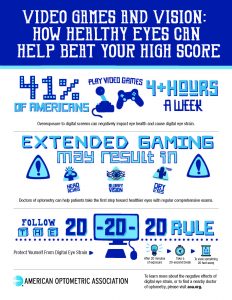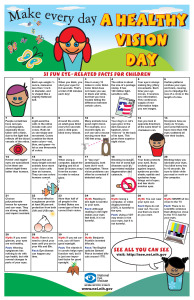Of all our senses, eyesight may be the one we count on the most. We use our eyes to play, learn and explore our world. It’s important to be sure that our eyes are the best they can be!
In the Kid’s Zone, SJEA will present fun and interesting eyesight-related information for children—both young and old.
Video Games and Vision: How Healthy Eyes Can Help Beat Your High Score
 South Jersey Eye Associates and the American Optometric Association Share How to Gain a Competitive Advantage by Giving Eyes a Break
South Jersey Eye Associates and the American Optometric Association Share How to Gain a Competitive Advantage by Giving Eyes a Break
[Bridgeton (March, 2018)] — With the popularity of video games and competitive gaming on the rise, players are always looking for an edge. Whether battling a computer opponent or Player Two, one secret weapon can help land the high score: the American Optometric Association’s (AOA) 20-20-20 rule, which encourages gamers to give their eyes a 20-second rest every 20 minutes.
The AOA’s 2017 American Eye-Q® survey revealed that 41 percent of Americans spend more than four hours a week playing video games. Staring at digital devices can lead to digital eye strain, sleep problems, blurred vision, headaches and neck and shoulder pain, among other things. Yet, only 21 percent of Eye-Q® respondents have talked to an eye health professional about the amount of time spent playing video games.
In addition to encouraging players to discuss game usage with an optometrist, South Jersey Eye Associates is sharing some insider tips on how to help ease eye discomfort during this year’s Save Your Vision Month in March.
- Level up with the AOA 20-20-20 rule: When you are using any electronic gaming device or computer, make a conscious effort every day to take a 20-second break and look away from the screen, every 20 minutes and view something 20 feet away.
- Position yourself: Maintain a comfortable working distance from your gaming device by using the zoom feature to see small print and details, rather than bringing the device closer to your eyes.
- Beat the glare: The AOA recommends reducing the glare by adjusting device settings or using a glare filter to decrease the amount of blue light reflected from the screen.
- Consider buying protective eyewear: Experiment with blue light filter glasses to limit the blue light beaming from your screen.
- Power down before you turn in: Turn your digital devices off at least one hour before bed.
- Schedule an appointment: Contact South Jersey Eye Associates to schedule an appointment for a comprehensive eye exam to detect and address vision problems.
“Those who spend excessive time in front of screens may experience physical discomfort, like the nearly one-third of gamers who reported headaches or blurry vision in our survey,” said Dr. Wuzzardo.
“Save Your Vision Month is the perfect time to prioritize eye health by practicing the 20-20-20 rule,” said Dr. Feinstein.
If you think you are experiencing any of the symptoms listed on the side due to prolonged exposure to digital devices, schedule an appointment with South Jersey Eye Associates. For additional information on how eye health may be impacted while playing video games, please visit www.aoa.org.
About the American Eye-Q® survey:
The American Optometric Association commissioned a 20-minute, online survey among a nationally-representative sample of n=1,002 U.S. adults ages 18+. The margin of error for this sample is +/-3.1% at the 95% confidence level. The survey was fielded between November 3 and November 9, 2017.
About the American Optometric Association (AOA):
The American Optometric Association, a federation of state, student and armed forces optometric associations, was founded in 1898. Today, the AOA is proud to represent the profession of optometry, America’s family eye doctors, who take a leading role in an individual’s overall eye and vision care, health and well-being. Doctors of optometry (ODs) are the independent primary health care professionals for the eye and have extensive, ongoing training to examine, diagnose, treat and manage disorders, diseases and injuries that affect the eye and visual system, providing two-thirds of primary eye care in the U.S. For information on a variety of eye health and vision topics, and to find an optometrist near you, visit www.aoa.org.
Dr. Cheri Wiggs, National Eye Institute, explains what our eyes do while we sleep and why we can’t see colors well in the dark.
VSP has partnered with Bill Nye the Science Guy and VSP Provider Dr. Roger Phelps for a series of four webisodes debunking popular eye health myths. In this episode, Bill and Dr. Phelps discuss the truth behind the symptoms of motion sickness some experience while watching 3-D and how to “get your eyes right” to enjoy 3-D movies. For more information visit www.facebook.com/vspvisioncare
Dr. Michael Steinmetz, National Eye Institute, explains why salt water stings our eyes, why it does not sting whales’ eyes, and whether opening our eyes in a pool is harmful.
Dr. Emily Chew, National Eye Institute, sheds light on common eye-related myths to tell us fact vs. fiction.
Ready to try a do-it-yourself optical illusion? Check out the link to a game below.
https://nei.nih.gov/kids/cool_eye_tricks
National Eye Institute Calendar – Make Every Day A Healthy Vision Day

 Eye See You At The Zoo
Eye See You At The Zoo
SJEA is very fond of Bridgeton’s very own Cohanzick Zoo and is a great supporter of their “Boo at the Zoo” event, having been a name sponsor from 2006 until 2016. When we first started this relationship, SJEA created the “Eye See You at the Zoo” program, an ongoing learning celebration on our website for children to learn more about the amazing world of eyesight—theirs and animals, too!
Check back often to find out what’s new at “Eye See You at the Zoo!”
Do insects have good eyesight?
The eyes of insects are very different from ours. Most insects—like the bee, butterfly, and beetle—have compound eyes, which means their eyes are divided into many sections each with its own little lens. Some insects, like ants, have as few as six lenses. The dragonfly has the most complex compound eye with as many as 30,000 lenses in each eye! A compound eye isn’t good at seeing detail or making out shapes. A honeybee only sees about 1/60 of what humans do. We would have to have compound eyes as large as our heads just to see as much as we normally do. A compound eye is extremely good at spotting motion though. Some insects have very large compound eyes that allow them to see almost all the way around them. That’s one reason why it’s practically impossible to sneak up on a housefly!
Does any creature have eyes in the back of its head?
Not exactly, but a chameleon comes pretty close. A chameleon’s bulging eyes can swivel and rotate independently from one another—which means that it can actually look in two different directions and at two different objects at the same time! This allows the chameleon to peer 360 degrees all around itself without ever moving its head. (Humans can’t see more than 180 degrees.) When the chameleon spots a tasty bug, it focuses on it with both eyes, getting a better look, so it can catch it with its sticky tongue.
Did you know that…
The fraction 20/20 is used to describe normal human vision. A hawk’s vision would measure closer to 20/5, which means the hawk can see things from 20 feet away that we would only be able to see from 5 feet away.
Why does an animal’s eyes glow at night?
Have you ever wondered why certain animal’s eyes—whether it’s your pet cat’s, a deer’s in the highway or a wolf’s on TV—glow spookily when caught in a beam of light in the dark?
It’s because of the “tapetum lucidum”, a carpet of mirror-like cells behind the animal’s retina, the layer of nerves at the back of the eye. It’s the retina that sends the messages to the brain about what the eye is seeing.
The tapetum lucidum improves an animal’s night vision by catching the light that passes all the way through the retina and bouncing it back, giving the animal another chance to “see” it. The tapetum lucidum greatly boosts an animal’s ability to see in the dark, which is why it’s mainly found in nocturnal animals.
Because different animals have different pigments in their eyes, they can give off
different color glows, from white to green to red.
Are Bats Really Blind?
No, bats aren’t actually blind at all. There are more than 1000 species of bat in the world. All of them can see and most have very good eyesight. In fact, fruit bats depend completely on their vision to find food. Many smaller bats use something called echolocation to help them hunt their insect meals and find their way in darkness; they bounce very high-pitched sounds off objects, like a delicious fly or mosquito, to determine their size, shape, distance and location. Although nocturnal bats—ones that sleep during the day and are active at night—may have better night vision than day vision, they are far from blind.
Do Dogs and Cats See in Black-and-White?
It’s a myth that dogs and cats only see in black-and-white. Scientists tell us that both dogs and cats have at least some color vision.
Studies show that cats have some limited ability to tell the difference between colors, but are slow to learn how—probably because it’s not a very useful skill for them to have. Dogs also have a limited amount of color vision. They can tell the difference between red and blue, but have problems distinguishing green from red—good thing they don’t need to read traffic lights! In humans, this same kind of colorblindness is called deuteranopia.
Cats and dogs both depend much more on movement and contrast—differences in brightness—than color to see objects.

